This is Part I of a two-part post. Tune in for Part II tomorrow.
Let’s start with the numbers.
Christianity is the world’s largest faith by sheer weight of numbers with more than 2.5 billion of the planet’s 7 billion people declaring themselves a Christian.
Easily the largest of these Christian denominations is the Catholic Church which counts roughly half of the world’s Christians in its 1.2 billion strong congregation. Protestants account for much of the remainder, representing around 800 million people, while major Orthodox Christian churches count more than 350 million adherents.
But while of these traditions are Christian, to talk of these denominations in general terms denies the diversity of each.
The world’s 1.2 billion Catholics, for example, are not members of a single church but rather dozens of different churches practicing different Catholic rites, with different religious traditions, and even including a half dozen ‘breakaway’ Catholic churches.
And the world’s Protestant congregation includes Baptists, Lutherans, Presbyterians, Congregationalists, Methodists, Hussites, and the Pentecostal churches, too.
The rich diversity of these traditions in the world means that a person claiming to be a follower of Jesus Christ could be a member of one of the world’s largest churches, part of a smaller national church, or even a member of a church that claims only a few thousand members globally. Indeed, talking theologically, the only thing all of these Christians have in common is a shared faith in Jesus Christ.
Which makes it rather peculiar that one of the smallest churches in the world has managed to find themselves at the top of Google searches the world over for those two words: Jesus Christ. Indeed, two of the top three results on Google’s search engine results page (SERP) for the phrase ‘jesus christ’ are from this same, relatively small denomination of Christianity, the Church of Jesus Christ of Latter Day Saints, also known as the LDS Church or Mormons.
How did this relatively small church manage to out rank every other church on Google?
How is it that one of the most competitive keyword searches is dominated by results pointing to this confession?
And what can the church’s success in rising to the top of one of Google’s most competitive pages teach SEO’s about successful search engine marketing?
In this post we’ll answer all of those questions and explain some of the reasons why – when you Google for Jesus – you find yourself at the Mormon church.
Googling for Jesus
Before diving too deep into how the LDS Church ranks so high for a competitive keyword like ‘jesus christ’ it’s worth reviewing just what the SERP for that phrase looks like.
Like so many Google SERPs the first link on the page for the keyword ‘jesus christ’ is advertising. The advertisement for the Little Creek Fellowship takes anyone who clicks to the website of a small, Adventist congregation in Clayton, North Carolina.
Next in line – and the first of the organic results – is the Wikipedia article on Jesus.
Surprised? You shouldn’t be. Wikipedia links are authoritative, linked widely, and are often the default reference point for online articles. It’s not always perfectly accurate, but it’s usually pretty fair and, if it’s detail you are after, then the 28,000-word entry on Jesus should satisfy all but the most ravenous amateur theologians.
And then, in second position, is the first non-paid, and non-Wikipedia link. It points to a site (jesuscrhist.lds.org) that is owned and maintained by, as the snippet suggests, the Church of Jesus Christ of Latter Day Saints. Of Google’s 175 million results for the keywords ‘jesus christ’, this is the page that outranks everything except Wikipedia.
Next on the SERP are news stories pulled directly from Google News.
If you are searching Google with an eye on what is happening in the right now rather than the hereafter, Google News has you covered. On this day the news about Jesus was fairly benign: a US presidential candidate with a painting of a smiling Christ, a link from a conservative opinion page, and a preacher reassuring his flock that heaven awaits.
Following the news is a relatively new addition to Google SERPs: a Google generated dropdown list of common search queries with snippet-length answers pulled directly from sites that the search giant finds reputable. These dropdowns may be useful for search engine users but remain controversial for content creators who see extracts of their content presented on the SERP and, as a result, may miss out on the clicks, visits, and traffic that a well written content piece can deliver.
Keep scrolling and you’ll find the next organic results for the keywords.
Who’s on top here?
Well the top result in this part of the SERP is a page on the mormon.org site, another Church of Latter Day Saints property. If you’re keeping score then that is two of the top three organic results pointing to the same Christian church.
For a church that counts perhaps 15 million adherents worldwide and represents just a little more than one-half of one percent of the global Christian faithful, this is extraordinary.
Further down the top results are links to Biography.com (similar to a for-profit version of the Wikipedia article), major media properties (BBC, PBS, and The Atlantic), ChristianAnswers.com (for the Christian seeking answers, one suspects), and in position 6 the website JesusChrist.com where you can sign up for your own, free @jesuschrist.com email address in just a few steps.
Hence, if you take away Wikipedia, news stories, and general information sites, there’s only one Christian faith on the first page of Google results for the keyword ‘jesus christ’, and that’s the Church of Jesus Christ of Latter Day Saints.
How did they achieve a ranking that Google has not bestowed on the far larger, more popular, and well-known Christian churches?
Read on.
Beginning with Backlinks
We started our analysis of the top-ranking LDS Church sites by looking at the backlinks that the sites have earned from other websites on the internet. This information is available via online services that specialize in keyword research and search engine optimization, and our preference in this regard is Majestic SEO.
Plugging the first of the LDS Church websites into Majestic SEO’s engine reveals the following basic information:
Pulling the key numbers from this data suggests that the first reason that the Mormons rank so well are their extensive backlinks to a specific page (jesuschrist.lds.org). Indeed, that page has more than 100,000 backlinks from nearly 900 individual domains.
Next to asses is the Majestic SEO Link Profile. By clicking on that purple-colored graph in the bottom right in the screenshot above we’re taken to another page of charted data that provides further details about the backlinks and the domains that supply them to the Mormon site.
The x-axis in both charts represents the Majestic SEO Citation Flow, an internal assessment of the number of links each page or domain has. This is something like a proxy for the quality of the page, or where it might fall on a Google SERP. The higher the score and the more to the right of the chart a domain or backlink is, the more valuable that referring domain or page is.
The y-axis in both charts represents another Majestic SEO signal, this time being Trust Flow. Trust Flow is a measure of how trustworthy a site is likely to be and, while Google and the other search engines have their own measures and rankings of trust, Majestic SEO is largely in line with their findings and trusted sites (Wikipedia, university sites, academic sites, and government sites for example) are more valuable sources of backlinks than a newly launched personal blog.
For both charts it is far better to find yourself linked by sites that bunch in the top right corner (highly trusted and often cited) than the bottom left corner (less trusted and less cited).
As is clear from the charts above for the JesusChrist.lds.org site, while the referring backlinks are crowded around the bottom left of the chart, there is significant spread in the referring domains. And, as the top right quadrant of the referring domain chart suggests, there are a number of significantly reputable and popular sites that link back to the JesucChrist.lds.org site and provide a fair proportion of the SEO ‘juice’ the site enjoys.
Let’s dig a little deeper into the nature of those backlinks.
The Backlink Breakdown chart gives some context to the 100,000 backlinks that the page has earned. The vast majority, unsurprisingly, are text links, with a smaller proportion links from images. Almost every link is a do-follow link, signaling to search engines that the site is trusted and credible according to the linking site.
When it comes to anchor text – that is, the text that is highlighted and clicked to send the visitor from a referring page or domain to the LDS Church site – it is clear that there is power headed the way of the church’s page. More than 1 in 10 of the referring links use the keyword (jesus christ) as the anchor text, and more than a third of the anchor text includes either one or both of the two words in the keyword phrase, or the ‘naked’ URL of the LDS Church page.
That’s a lot of backlink juice and a big reason that the page has made its way to the top of the 175 million-strong Google ranking.
But backlinks are only part of the reason that the LDS Church is on top of page one for one of the most competitive search terms on the internet…
In Part II of this research coming tomorrow we’ll explain what else the LDS Church has done to make sure it is in SEO heaven.


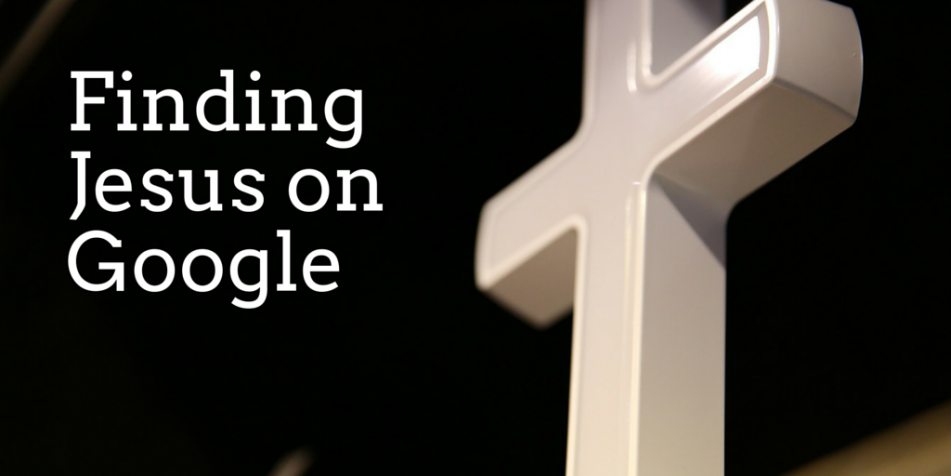
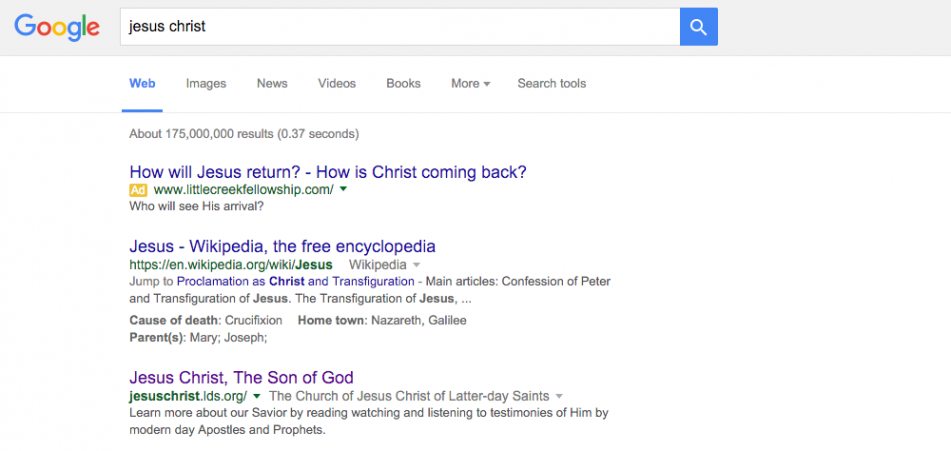


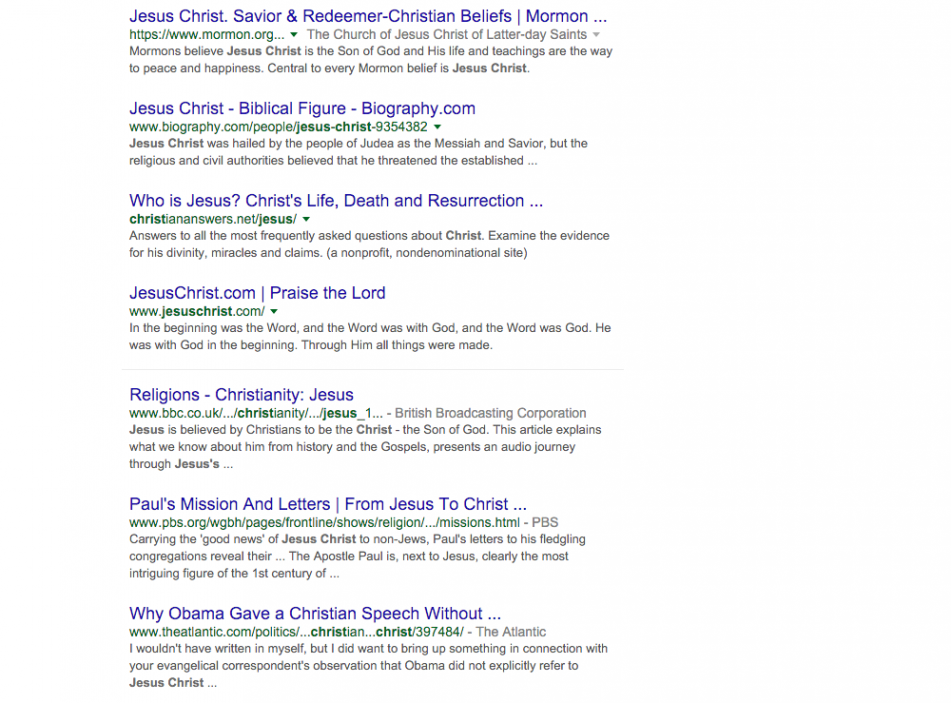
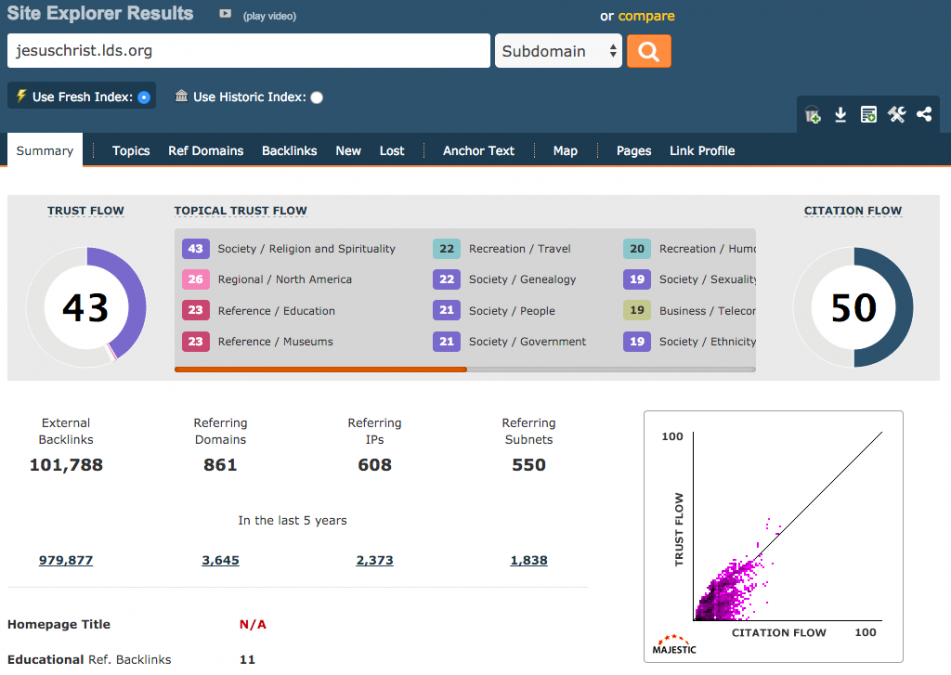
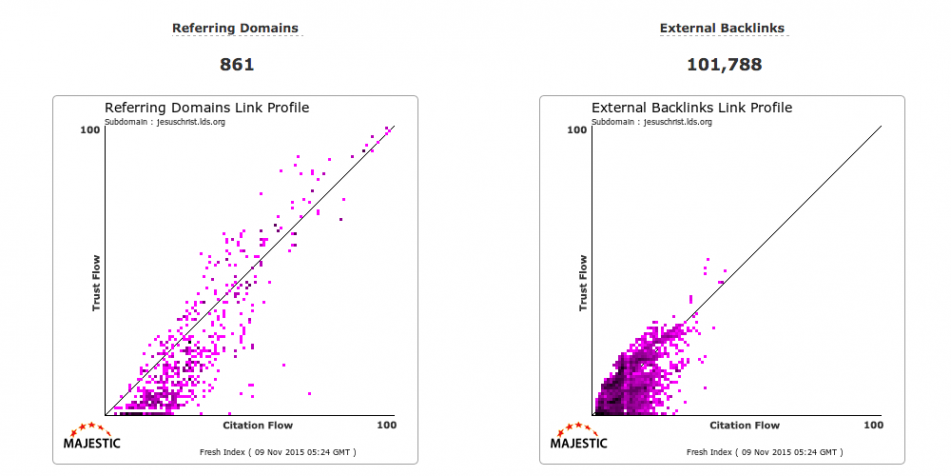
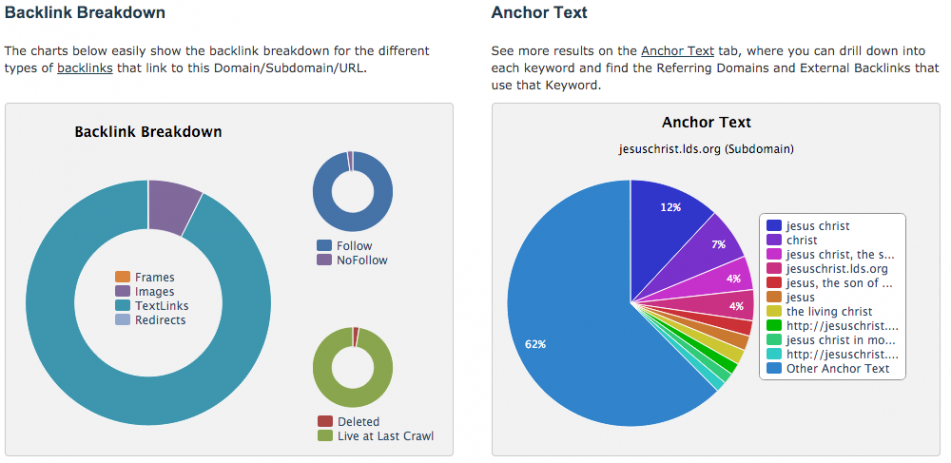
18 Comments
843388 832943Hiya! Great weblog! I happen to be a daily visitor to your website (somewhat much more like addict ) of this site. Just wanted to say I appreciate your blogs and am looking forward for more! 162184
Wow! Your blog post blew me away! Your ability to dissect complex topics and present them in a relatable, no-nonsense way is simply genius. Allow me to share with you and your audience about my first-hand experience of this ultimate Giant Killer! =>> (https://bit.ly/ai-biz-builder). With only One Keyword, One Description and One Click, this revolutionary AI-powered wizardry Business Builder and Marketing Assistant crushes any competitors to achieving the Superior Lead Conversion by way of creating seamlessly all-in-one tasks similar to the likes of Wix, Hubspot, Chatgpt to Jasper, Canva, Invideo to Adode Photoshop, Midjourney, Speechelo to Convertkit, Pushit and many more. No other AI tools can compete with its dominance. Harness the unrivaled power of this Giant Killer and realize your business’s true potential. And here’s the cherry on top! During this exclusive launch, you can access all these incredible benefits for a limited one-time fee. Plus, a generous list of bonuses to fuel your business growth and add immense value to your establishment. I am so confident that you’ll fall head over heels for this product as it comes with a 30-Day Money-Back Guarantee. It’s a risk-free opportunity you simply can’t miss! Trust me, I’m not just blowing smoke. I’ve personally experienced the sheer awesomeness of this product, and I’m not alone. Over 15,000 users have already joined the revolution, and the numbers keep growing. Don’t wait, click here =>> (https://bit.ly/ai-biz-builder) to dominate the market today! For Indepth Video Guide and Reviews, Visit =>> https://bit.ly/biz-builder-bot
Hey Blog Owner. I found myself nodding along while reading your blog post. How you capture the essence of the subject matter and communicate it with such wit and clarity is absolutely astonishing. Anyways, I found this helpful site and I thought I’d share with those who are being affected by the current turmoils as I personaly did reap its benefit recently. Do Apply and Utilise Responsibly for its Unparalleled Results. Unleash the full potential at https://cutt.ly/cashinject. Tailored to catapult your success amidst the ever-changing economic landscape. Whether you’ve been directly impacted or are proactively preparing to overcome its unpredictable effects, this program and facility holds the key to secure financial stability. Yet, be wise – take calculated steps in order to reap the rewards. For More Detailed Guide, Visit –>> https://cutt.ly/AwuanHdD
I just wanted to share my appreciation for the aesthetically pleasing design of your blog. It’s invigorating to come across a website that combines aesthetics with informative articles. You’ve truly created a great balance! Hey there, fellow readers and especially to all those weight loss warriors! Have you heard about Alpilean? -> https://cutt.ly/Bwich6l2 Let me tell you, this stuff is hotter than a jalapeño on a summer day! 🔥🌶️ I’ve been on the weight loss journey for ages, trying everything under the sun with lackluster results. But Alpilean? It’s a game-changer! It takes weight loss to a whole new level of fire and intensity. Visualize melting away those stubborn pounds, boosting your metabolism, and feeling like an unstoppable force. That’s what Alpilean does, my friends. It’s like a furnace for fat, burning through it with blazing determination. Don’t waste another moment on mediocre supplements that leave you feeling disappointed. Trust me, I’ve been there. But Alpilean? It’s the real deal. It’s the secret weapon you’ve been waiting for! So, if you’re ready to unleash your inner weight loss warrior, get your hands on yourself some Alpilean and let the inferno begin! Don’t wait around—click that link and get ready to set your weight loss journey on fire! 🔥💪 P.S. They’ve got some smokin’ discounts going on right now with a 90-day refund, so don’t miss out. Get your hands on Alpilean -> https://cutt.ly/Bwich6l2 and watch the pounds melt away like magic! 💥💥 For Review, Visit -> https://cutt.ly/ywicmHnd
Sutter Health
Good day! I simply want to give you a big
thumbs up for the excellent information you have
here on this post. I’ll be returning to your web site for more
soon.
Hi there, I enjoy reading all of your article post. I
wanted to write a little comment to support you.
Hello there, just became aware of your blog through
Google, and found that it is truly informative. I am going to watch out for brussels.
I’ll appreciate if you continue this in future.
Lots of people will be benefited from your writing.
Cheers!
7860 689945Hello! I just now would pick to supply a enormous thumbs up with the great information you could have here within this post. I will likely be coming back to your blog site for additional soon. 920409
744716 790316Awesome post , Im going to spend more time researching this subject 465042
meditation music
This is really interesting, You are a very skilled blogger.
I have joined your feed and look forward to seeking more of your magnificent post.
Also, I have shared your site in my social networks!
Great website. Lots of useful information here. I look forward to the continuation.
For the reason that the admin of this site is working no uncertainty very quickly it will be renowned due to its quality contents.
This is my first time pay a quick visit at here and i am really happy to read everthing at one place
I do not even understand how I ended up here but I assumed this publish used to be great
852005 231878I got what you intend, saved to fav, very nice website . 617476
336770 597095This internet website is my inspiration , really exceptional layout and perfect topic matter. 282075